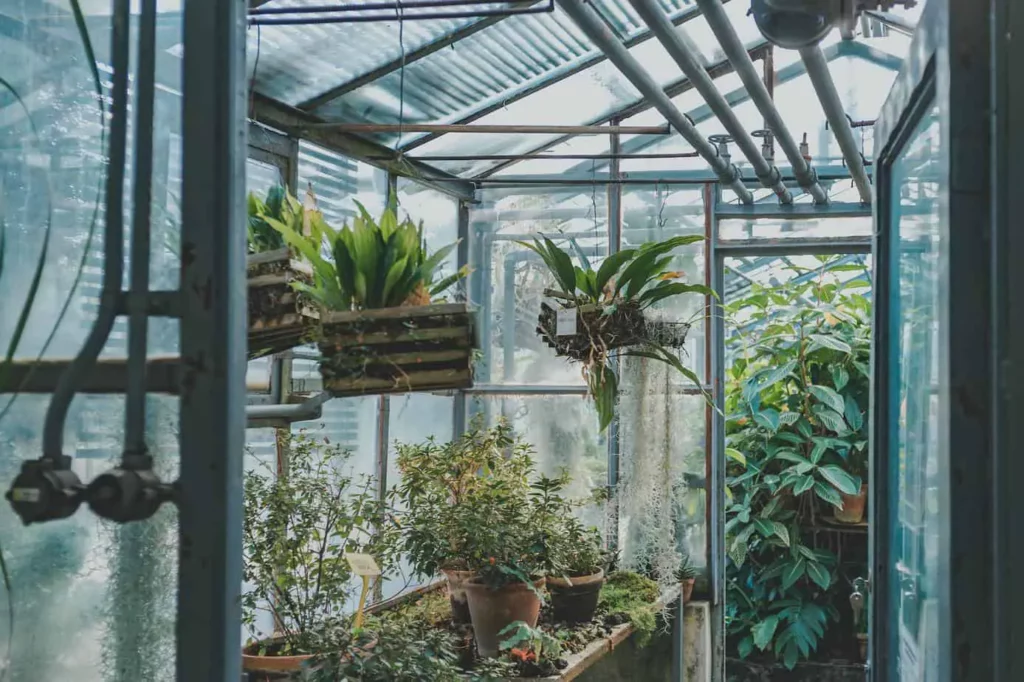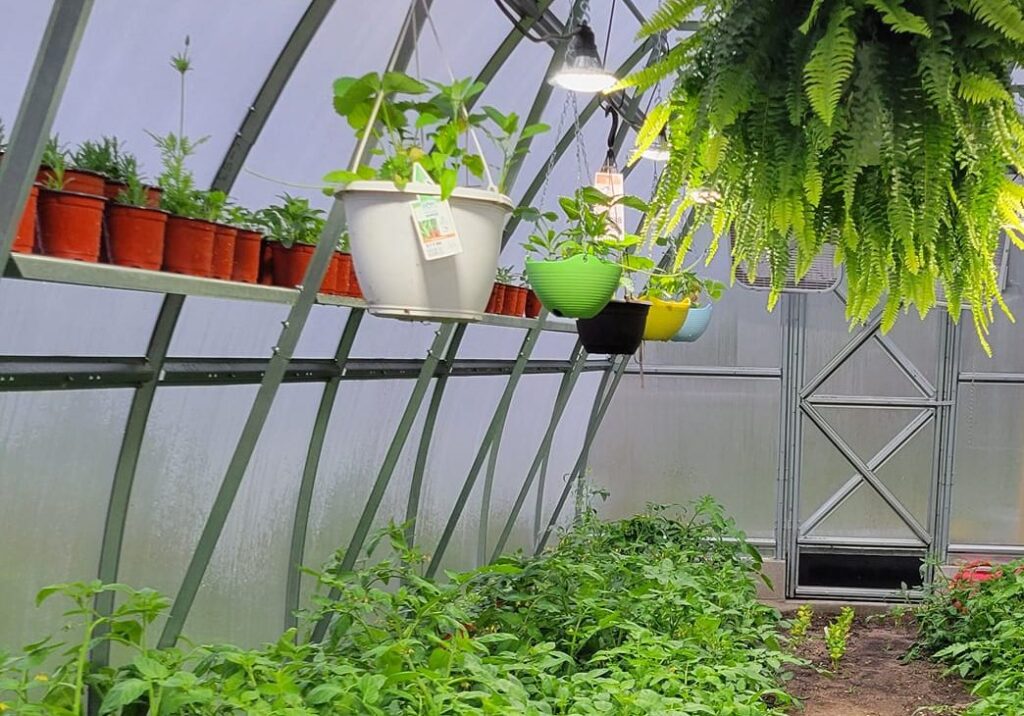As I stand amidst the vibrant green oasis of my greenhouse, I am reminded of the sheer delight that comes from nurturing and cultivating a world of thriving plants within these transparent walls. The art of organizing a greenhouse is akin to orchestrating a symphony of nature’s finest creations.
But the question is “How to organize a greenhouse”
I identified the best ones after completing an in-depth investigation. The following advice has been structured to help you utilize your greenhouse area to the fullest.
By incorporating zoning, shelving, a potting bench, designated rubbish disposal, staging, hooks and hanging systems, plastic storage tubs, accessible hand tools, and a dedicated area for seeds and planting, you can elegantly organize your greenhouse.
However, with each step and decision, I have learned that harmony, precision, and patience are the keys to success in this verdant sanctuary. In this personal journey, I will share the insights and techniques that have allowed me to transform my greenhouse into a haven of flourishing flora.
So, let’s embark on this journey together, where the beauty of horticulture knows no bounds.
Efficient Strategies for Organizing Your Greenhouse

Zoning: Start by creating distinct zones within your greenhouse. Allocate areas for potting, storage, and separate spaces for edible and non-edible plants. Ensuring that everything has its designated place will save you valuable time and prevent the frustration of searching for tools or supplies when you need them.
Moreover, a clutter-free space promotes better ventilation and reduces hiding spots for unwanted pests.
Shelving: In a narrow greenhouse, shelving is a brilliant way to maximize vertical space. You can choose between freestanding or wall-mounted options, depending on your greenhouse’s layout.
Also, Opt for slatted designs that allow light to filter through, promote air circulation, and facilitate drainage. Adjustable shelves are handy for efficient storage, and clear plastic boxes keep items visible and organized.
Potting Bench: Establish a dedicated potting area equipped with all necessary tools and equipment. Potting benches not only provide a convenient workspace for gardening in all weather conditions but also offer additional storage options.
Then, customize your potting bench with hooks and hanging buckets for small tools, labels, twine, and scissors. Store pots and compost underneath to keep everything tidy.
Rubbish: Efficient waste management is often overlooked but is crucial for greenhouse cleanliness and organization. Set up separate bins for compostable materials and general waste. If you have a larger greenhouse, consider using a bin on wheels to easily move it around as you work, keeping the workspace clean and organized.
Staging: Staging, whether DIY or store-bought, offers ample surface area for your plants and seedlings. Opt for materials like plastic or steel over wood to prevent overwintering pests. Combination staging with solid surfaces on top and slat shelving below is ideal for various gardening items.
Hooks and Hanging: Make the most of your greenhouse’s vertical space by installing hooks on wooden rafters or the aluminum frame. Hang small tools, watering cans, hanging baskets, or even herbs to maximize space and organization. Get creative with pegs or bulldog clips to secure gardening gloves and seed packets.
Plastic Storage Tubs: Keep your greenhouse floor tidy with stackable, flexible plastic tubs. They are particularly useful for controlling open bags of compost and can be equipped with wheels for easy mobility.
Hand Tools: Efficiently store small gardening tools by repurposing items like empty paint buckets or umbrella stands. A sand and oil mixture in a paint bucket can keep metal hand tools rust-free, clean, and sharp. For larger tools, consider a purpose-built tool rack.
Seeds and Planting: Stay organized by setting up a DIY planting calendar using a length of ribbon. Pin up seed packets for each month, serving as a visual reminder for planting tasks.
All-Purpose Garden Organization: Repurpose everyday household items for garden organization. Wall-mounted toilet roll holders, wicker bike baskets, cutlery drawer organizers, and bungee cords can all be adapted to help keep your greenhouse tidy and efficient.
Maintaining Greenhouse Cleanliness: A Vital Annual Task
Hygiene plays a pivotal role in safeguarding plant health, particularly when nurturing young seedlings and unrooted cuttings, “In winter or during cool, humid spells of weather, fungal diseases are widespread. Cleaning is an essential part of planning a greenhouse.”
Furthermore, each autumn, embark on a comprehensive greenhouse cleaning mission, addressing both the interior and exterior. Opt for mild disinfectant cleaning solutions, such as gentle washing-up liquid, and, crucially, rinse away any residue thoroughly.
Here are my recommendations, that i do personally:
- Gently sweep down benches and frames with a soft brush, giving shelving units a thorough scrub.
- Meticulously wash all pots to prevent potential pest infestations within.
- Sweep and cleanse the floor and ceiling diligently, eradicating any algae that may have developed during the summer months.
- Clear away leaves and debris from the gutters on the exterior of the greenhouse.
- Annually, drain and refresh reservoirs and water butts to ensure the water remains pristine, devoid of stagnation.
HOW DO YOU ORGANIZE THE INSIDE OF A GREENHOUSE?
- Tailor your greenhouse layout to align with your specific cultivation goals.
- Efficiently use space by integrating shelving, staging, and partitions.
- Consider aluminum staging options that can be powder-coated to match or contrast with your greenhouse’s design.
- Partitions, acting as internal glass walls, enhance aesthetics and create distinct zones for different plants.
- Use partitions to manage varying climates and to separate growing areas from leisure spaces within the greenhouse.
- Maintain a balanced mix of bench and shelving levels to accommodate different plant needs.
- Lower benches are ideal for dormant plants like cyclamen corms and for organizing gardening tools.
- Top shelf staging mimics the natural habitat of orchids, promoting their healthy growth.
Upgrade Your Greenhouse Organization with These 5 Essential Tools
Garden Collector:
Running a greenhouse generates waste, from dirt to dead plants, that can’t just be tossed aside. Enter these 25-gallon bags, the ideal solution for collecting refuse in your greenhouse or garden.
In addition, crafted from UV-protected, laminated polypropylene fabric for robustness, these bags are built for long-term use. What sets them apart is the plastic ring sewn into the seam, ensuring the top stays open—a feature lacking in other garden bags. Plus, the handles are designed for extended use, even when carrying heavy waste.
Amazon Basics Adjustable Shelving Unit:
Sometimes, simplicity reigns supreme. While you could pile all your gardening tools, seeds, and pots onto a single bench in your greenhouse, a more organized approach is desirable. These shelves can support up to 250 pounds, guaranteeing the safety of your items, no matter how much you load them with.
Also, with three adjustable shelves, you can tailor the unit to individual preferences. And, the timeless chrome finish adds a touch of classic style to your greenhouse setup.
FOYUEE Raised Planter Box:
In most greenhouses, gardeners grow a variety of plants to maximize space and yield. However, managing this diverse array can be a challenge. The FOYUEE raised planter box combines aesthetics with functionality.
Additionally, its sleek metallic black design and back wheels make it visually appealing and easily portable. Holding 2.5 cubic feet of soil, this planter box offers ample growing space and includes a handy shelf below for storing tools.
Novelinks Photo Case:
While purchasing a photo case for your greenhouse might seem unconventional, it has its merits. Designed for 4×6-inch photos, these cases are the perfect size for organizing seed packs.
Then , each case includes individual interior cases that you can categorize—perhaps one for tomatoes, one for peppers, and so on. This storage system simplifies seed retrieval, ensuring you can quickly locate what you need without fuss. Plus, the case keeps your seeds organized, neat, and dry, all while maintaining a timeless look suitable for any greenhouse.
Organizer Rack with Steel Pegboard:
Maintaining order in your greenhouse is crucial, especially when it comes to tools. This organizer rack, mountable on the wall, provides an efficient solution. Pegboards allow you to customize the rack to your requirements, and the wall-mounted design saves valuable floor space while allowing you to see all your tools at once. This visual cue helps you identify missing items or assess whether it’s time to acquire new ones.
Does A Greenhouse Need Planning Permission?

Yes, Whether a greenhouse requires planning permission depends on various factors, including your location, the size of the greenhouse, and local zoning regulations. Here are some general guidelines to consider:
Size Matters: Small, temporary greenhouses usually don’t need permission. But if it’s big and permanent, you might.
Check Local Rules: Different places have different rules. So, you need to see what your local area says.
Special Areas: If you live in a special place like a listed building or conservation area, there might be stricter rules.
Space and Looks: Rules might say how close a greenhouse can be to other stuff and how it looks.
Nature: Sometimes, rules consider how a greenhouse affects the environment.
Change of Use: If you want to use the greenhouse for something other than gardening, you might need permission.
Temporary vs. Permanent: Temporary ones are often treated differently from permanent ones.
FAQs
How do you plan a greenhouse layout?
Plan a greenhouse layout by considering factors like sunlight, plant types, and space efficiency. Sketch the layout, place taller plants in the center, and install proper shelving or benches for organization.
What is the best structure for a greenhouse?
The best greenhouse structure depends on your needs and budget. Common options include hoop houses, quonset-style, and traditional gable-roof greenhouses. Choose one that suits your climate and purpose.
How do you organize tools in a greenhouse?
Organize tools in a greenhouse by using hooks, pegboards, or a dedicated tool shed nearby. Keep tools clean and accessible, ensuring they don’t obstruct plant growth or safety.
How do you manage a greenhouse?
Successful greenhouse management involves monitoring temperature, humidity, watering, and pest control. Regularly inspect plants for signs of disease or stress and adjust conditions accordingly.
What is a greenhouse management system?
A greenhouse management system is a technology-driven solution that helps automate and monitor greenhouse operations. It can control climate, irrigation, and data analysis for optimal plant growth.
How do you organize a large greenhouse?
In a large greenhouse, create designated zones for different plant types, install irrigation systems, and use benches or shelving for efficient space utilization. Regular maintenance and monitoring are crucial for large-scale success.
Conclusion
To wrap up, organizing and maintaining a greenhouse is not just a hobby, but a labor of love and a sanctuary for my plants. The careful planning and thoughtful setup of distinct zones, shelving, potting benches, and storage solutions have made my greenhouse a haven of efficiency and productivity.
Additionally, with hooks, shelves, storage tubs, and creative repurposing of household items, I’ve maximized every inch of space and made organization a breeze. From potting to planting, everything has its designated place, saving me time and minimizing frustration.
Furthermore, a well-organized and clean greenhouse not only fosters better plant growth but also provides a serene space for me to nurture my passion for gardening. It’s a place where I can escape the chaos of the outside world and connect with nature.
So, for any fellow greenhouse enthusiasts out there, I highly recommend taking the time to create an organized and clean oasis—it’s an investment that pays off in the beauty and health of your plants and the joy it brings to your heart. Happy gardening!

